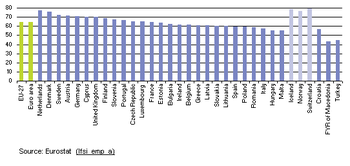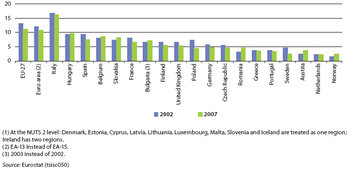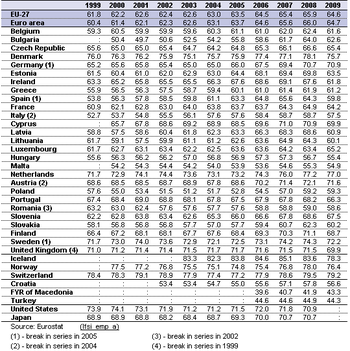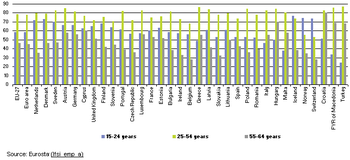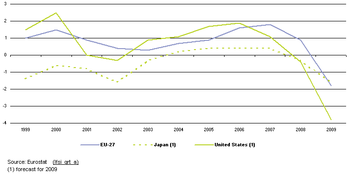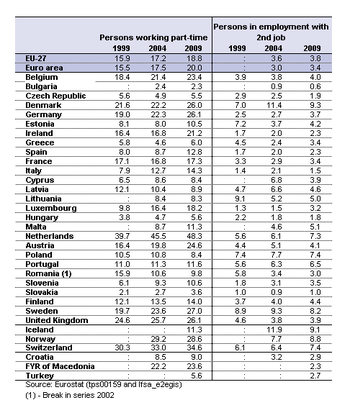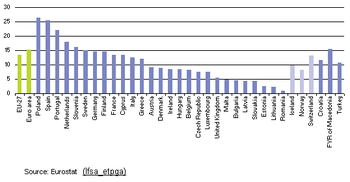Archive:Employment statistics
- Data from July 2010, most recent data: Further Eurostat information, Main tables and Database.
European Union (EU) citizens have the right to work in any Member State without work permits. Although there are some temporary restrictions on workers from the countries which have joined the Union since 2004, this freedom of movement aims to help create a single market for jobs. This could potentially boost the economy while helping thousands of people achieve their career and lifestyle aspirations.
All EU citizens that move to work in another Member State must be treated as nationals in terms of employment rights that cover work-related issues like pay and dismissal. Nevertheless, job mobility within the EU remains relatively low, with only 2 % of the working-age population living and working in another Member State. As highlighted in the article below, employment rates vary considerably across regions, and are influenced by different levels of educational attainment.
Main statistical findings
Total employment rate and differences by sex and age
The EU employment rate for persons aged 15 to 64 as measured by the European Union Labour Force Survey (EU LFS), decreased in 2009 to 64.6 %, down from 65.9% in 2008. This is a decrease of 1.3 percentage points, making it the first time the EU employment rate decreases since Eurostat estimates this indicator for the EU27. The EU employment rate recorded in 1998 was 61.2%. The Lisbon European Council in 2000 set a target of 70% to be achieved by 2010. In 2009, employment rates above 70 % were achieved in five Member States (Denmark, the Netherlands, Sweden, Austria, and Germany). In contrast, employment rates below 60 % were recorded in Malta, Hungary, Italy, Romania, Poland and Spain.
Employment rates vary considerably not only across but also within the Member States according to regional patterns, with a relatively high dispersion (16.3 %) observed across Italy (as measured by the coefficient of variation for regions at NUTS 2 level). In contrast, there was relatively little divergence in employment rates across the regions of Austria, Greece, Portugal, Sweden or the Netherlands (all below 4 %). The dispersion of regional employment across the whole of the EU was seen to be declining, as the coefficient of variation declined from 13.2 % to 11.1 % between 2002 and 2007.
Employment rates are generally lower among women and older workers. In 2009, the employment rate for men reached 70.7% in the EU, as compared to 58.6 % for women. Those values follow after 72.8% and 59.1%, respectively for men and women, in 2008. The values recorded in 2009 exceed those of 1998, significantly for women (52.0% in 1998) and marginally for men (70.3% in 1998). The Lisbon European Council set a 2010 target employment rate for women of 60 %. 14 Member States recorded employment rates for women above the 60 % target in 2009, with Denmark, Sweden and the Netherlands exceeding 70 %.
On their side, the EU employment rate for older workers (aged between 55 and 64) reached 46.0 % in 2009, as compared to 45.6% in 2008, and much higher than the rate recorded in 2001 (40.0 %). The Stockholm European Council of 2001 set a 50 % target employment rate for older workers by 2010. In 2009 this target was reached or exceeded in 11 Member States. The highest rates were recorded in Sweden (70.0 %) and Estonia (60.4%).
Differences by educational attainment levels, part-time and fixed-term contracts
The employment rate varies considerably according to the level of educational attainment. The employment rate of those aged 25 to 64 [1] who had completed tertiary education was 84.5 % across the EU in 2009, much higher than the rate (54.7 %) for those who had only attained a low educational level (primary or lower secondary education). The employment rate of persons with medium level of educational attainment lay in between, at 73.7%.
The proportion of the EU workforce reporting their main job as part-time increased steadily from 15.9 % in 1998 to 18.8 % by 2009. The highest proportion of part-time workers was found in the Netherlands (48.3 % in 2009), followed by Sweden, the United Kingdom and Denmark, where part-time work accounted in each case for over a quarter (26-27%) of those in employment. In contrast, part-time employment was relatively uncommon in Bulgaria (2.3 % of employment) and Slovakia (3.6 %). The incidence of part-time work differs significantly between men and women. A little less than one-third (31.0 %) of women employed in the EU worked part-time in 2009, a much higher proportion than men (7.4 %). Three-quarters (75.7 %) of all women employed in the Netherlands worked on a part-time basis in 2009, by far the highest rate among the Member States [2].
The EU share of employees with a contract of limited duration (fixed-term employment) was 13.5% in 2009, down from 14.0% in 2008 and 14.5% in 2007. In 2009, more than one quarter of employees had a temporary contract in Spain and Poland, and the share was more than one fifth in Portugal. Among the remaining Member States, the proportion of employees working on a contract of limited duration ranged from 18.0% in the Netherlands, down to just 1.0 % in Romania. The considerable range in the propensity to use limited duration contracts between Member States may, at least to some degrees, reflect national practices, the supply and demand of labour, and the ease with which employers can hire or fire.
Data sources and availability
The main data source for labour market statistics is the European Union Labour Force Survey (EU LFS). Another frequently used source for employment is National Accounts. Both sources use broadly similar employment definitions based on international standards from the International Labour Organization and the System of National Accounts, respectively. A third source for information on emloyment is enterprise statistics.
The data source for all indicators given here is the EU LFS except for the employment growth, which is based on National Accounts. National Accounts publishes employment estimates with no age thresholds nor socio-demographic breakdowns, which makes data more suitable for analysis of employment as a labour input to production activities rather than as a social pheneomenon.
The EU LFS is a quarterly sample survey covering the population in private households in the EU, EFTA (except Liechtenstein) and Candidate Countries. It provides annual and quarterly results on labour participation of persons aged 15 and over. The EU LFS collects information on labour force status (all persons being either in employment, unemployed or economically inactive), employment characteristics, working time, job search among unemployed, levels od education, recent education and training as well as individuals' demographic background and family composition.
The EU LFS sample size amounts approximately to 1.5 million individuals each quarter. The quarterly sampling rates vary between 0.2% and 3.3% in each country. Eurostat started the collection of LFS microdata in 1983 with one reference quarter per year (usually in spring). In the period from 1998 to 2005, the survey underwent a transition to a continuous quarterly survey. In the meantime, all EU countries provide quarterly results.
Definition of employment and main employment characteristics
The economically active population (labour force) comprises employed and unemployed persons.
The EU LFS defines persons in employment as those aged 15 and over who during the reference week performed some work, even for just one hour per week, for pay, profit or family gain. It also includes people who were not at work but had a job or business from which they were temporarily absent, for example, because of illness, holidays, industrial dispute and education or training.
Employment can be measured in number of persons, number of jobs, full-time equivalents or hours worked. All the estimates given here use number of persons. Employment rates are also built on estimates of number of persons. Employment statistics are frequently reported as employment rates to discount the changing size of countries' populations along time and to facilitate comparisons between differently-sized countries. Employment statistics are typically published for the working age population, which is 15-64 in the EU and Member States, except 16-64 in Italy, Spain, Sweden (only until 2001), the United Kingdom and Iceland. This age group is also the standard for other international statistical compilations.
Annual employment growth gives the change in percentage terms from one year to another of the total number of employed persons on the economic territory of the country or the geographical area. The data source for employment growth is National Accounts.
Some main employment characteristics, as defined by the EU LFS, are the following:
Employees are defined as those who work for a public or private employer and who receive compensation in the form of wages, salaries, payment by results or payment in kind; non-conscript members of the armed forces are also included. Self-employed persons work in their own business, farm or professional practice. A self-employed person is considered to be working during the reference week if she/he meets one of the following criteria: works for the purpose of earning profit; spends time on the operation of a business; or is currently establishing a business.
A full-time/part-time distinction in the main job is declared by the respondent, except in Germany, Ireland and the Netherlands, where thresholds for usual hours worked are used.
An employee is considered as having a temporary job if employer and employee agree that its end is determined by objective conditions, such as a specific date, the completion of an assignment or return of the employee who was temporarily replaced. Typical cases include: people in seasonal employment; people engaged by an agency or employment exchange and hired to a third party to perform a specific task (unless there is a written work contract of unlimited duration); people with specific training contracts.
The dispersion of regional (NUTS level 2) employment rates shows regional differences in employment within countries and groups of countries (EU, euro area). It is zero when the employment rates in all regions are identical, and will rise if there is an increase in the differences between employment rates among regions. The indicator is not applicable for several countries as these comprise only one or a handful of NUTS level 2 regions. However, the employment rates of these countries are used to compute the indicator at a European level.
Context
Flexible working conditions – for example, part-time work or work from home – are thought to stimulate employment and activity rates, by encouraging more persons to enter the labour force. Other initiatives that may encourage a higher proportion of people to enter the labour market include improvements in the availability of childcare facilities, or providing opportunities for lifelong learning. Nevertheless, job mobility within the EU remains relatively low, as about 2 % of the working age population of the EU currently lives and works in another Member State.
Central to this theme is the issue of ’flexicurity’: policies that simultaneously address the flexibility of labour markets, work organization and labour relations, while taking into account the reconciliation of work and private life, employment security and social protection. It is often argued that if individuals and couples cannot achieve their desired work/family life balance, this affects not only their personal welfare but also economic development by reducing the labour supply. In this way, flexible working arrangements can be viewed as encouraging more people into work, while liberating individuals to decide whether to try to have a family or spend more time with children. In contrast, an inflexible labour market can actually lead to a reduction in birth rates, which has clear repercussions for future labour supply, as well as the knock-on effects regarding the financial sustainability of social protection systems.
Further Eurostat information
Publications
- Living conditions in Europe – Statistical pocketbook – Data 2003-2006
- The social situation in the European Union 2009
Main tables
- LFS main indicators (t_lfsi)
- Population, activity and inactivity - LFS adjusted series (t_lfsi_act)
- Employment - LFS adjusted series (t_lfsi_emp)
- Employment growth by gender (tsieb050)
- Employment rate by gender (tsiem010)
- Employment rate of older workers by gender (tsiem020)
- Persons employed part-time - Total (tps00159)
- Employees with a contract of limited duration (annual average) (tps00073)
- LFS series - Detailed annual survey results (t_lfsa)
- Employment rate, by highest level of education attained (tsdec430)
- Employed persons with a second job (tps00074)
- Hours worked per week of full-time employment (tps00071)
- Hours worked per week of part-time employment (tps00070)
- Unemployment rates of the population aged 25-64 by level of education (tps00066)
Database
- LFS main indicators (lfsi)
- Population, activity and inactivity - LFS adjusted series (lfsi_act)
- Employment - LFS adjusted series (lfsi_emp)
- Unemployment - LFS adjusted series (une)
- Education and training - LFS adjusted series (lfsi_edu)
- LFS series - Detailed quarterly survey results (from 1998) (lfsq) (Information on NACE Rev.2)
- Total population - LFS series (lfsq_pop)
- Activity and activity rates - LFS series (lfsq_act)
- Employment - LFS series (lfsq_emp)
- Employment rates - LFS series (lfsq_emprt)
- Self employed - LFS series (lfsq_empself)
- Employees - LFS series (lfsq_emppaid)
- Temporary employment - LFS series (lfsq_emptemp)
- Full-time and part-time employment - LFS series (lfsq_empftpt)
- Population in employment having a second job - LFS series (lfsq_emp2job)
- Working time - LFS series (lfsq_wrktime)
- Total unemployment - LFS series (lfsq_unemp)
- Inactivity - LFS series (lfsq_inac)
- LFS series - Detailed annual survey results (lfsa) (Information on NACE Rev.2)
- Total population (lfsa_pop)
- Activity and activity rates - LFS series (lfsa_act)
- Employment - LFS series (lfsa_emp)
- Employment rates - LFS series (lfsa_emprt)
- Self employed - LFS series (lfsa_empself)
- Employees - LFS series (lfsa_emppaid)
- Temporary employment - LFS series (lfsa_emptemp)
- Full-time and part-time employment - LFS series (lfsa_empftpt)
- Population in employment having a second job - LFS series (lfsa_emp2job)
- Population in employment working during asocial hours - LFS series (lfsa_empasoc)
- Working time - LFS series (lfsa_wrktime)
- Total unemployment - LFS series (lfsa_unemp)
- Inactivity - LFS series (lfsa_inac)
- LFS series -Specific topics (lfst)
- LFS ad-hoc modules (lfso)
Dedicated Section
Other information
- Labour Force Survey in the EU, Candidate and EFTA countries - Main characteristics of the 2008 national surveys - 2009 Edition
- Quality Report of the European Union Labour Force Survey 2007
External links
OECD - Statistics Portal - Labour
See also
Notes
For Switzerland only spring LFS results (quarter 2) are available and used as annual estimates in the respective tables and charts.
